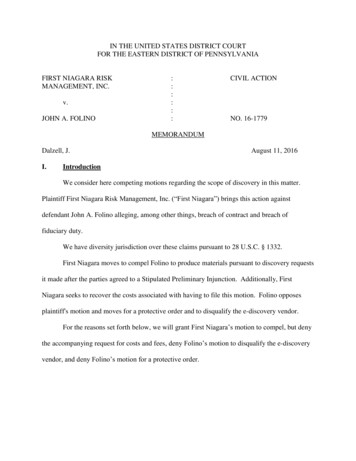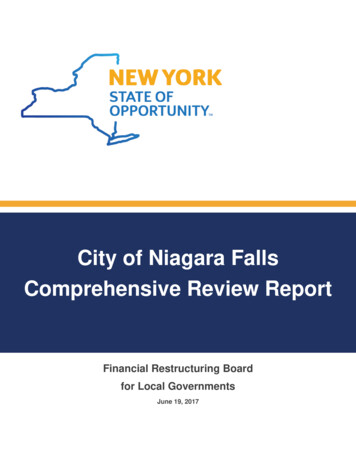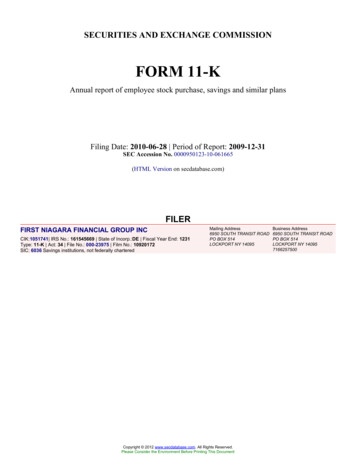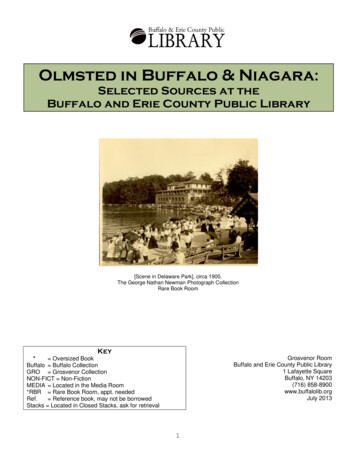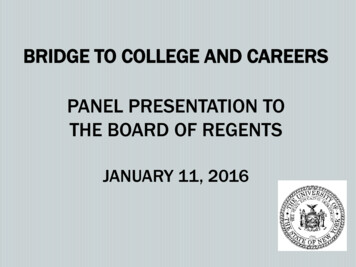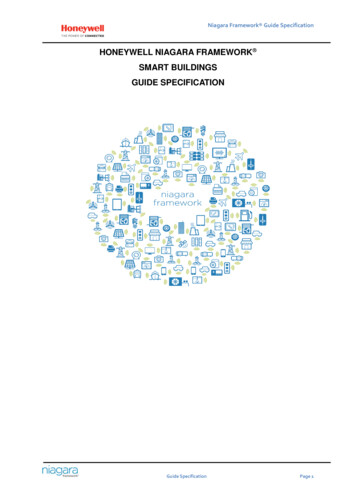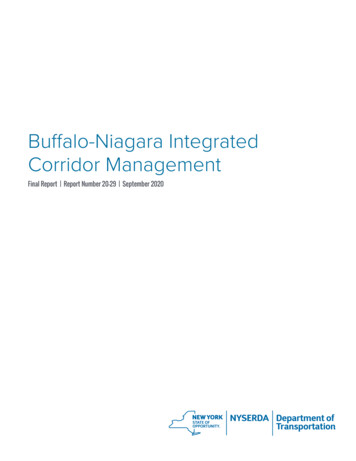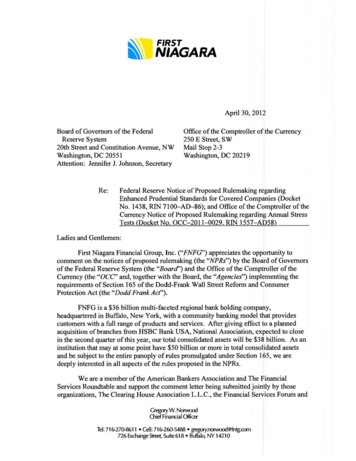
Transcription
FIRSTNIAGARAApril 30, 2012Board of Governors of the FederalReserve System20th Street and Constitution Avenue, NWWashington, DC 20551Attention: Jennifer J. Johnson, SecretaryRe:Office of the Comptroller of the Currency250 E Street, SWMail Stop 2-3Washington, DC 20219Federal Reserve Notice of Proposed Rulemaking regardingEnhanced Prudential Standards for Covered Companies (DocketNo. 1438, RIN 7100-AD-86); and Office of the Comptroller of theCurrency Notice of Proposed Rulemaking regarding Annual StressTests (Docket No. OCC-2011-0029. RIN 1557-AD58)Ladies and Gentlemen:First Niagara Financial Group, Inc. ("FNFG''') appreciates the opportunity tocomment on the notices of proposed rulemaking (the "'NPRs") by the Board of Governorsof the Federal Reserve System (the "Board") and the Office of the Comptroller of theCurrency (the " O C C and, together with the Board, the "Agencies") implementing therequirements of Section 165 of the Dodd-Frank Wall Street Reform and ConsumerProtection Act (the "Dodd Frank Act").FNFG is a 36 billion multi-faceted regional bank holding company,headquartered in Buffalo, New York, with a community banking model that providescustomers with a full range of products and services. After giving effect to a plannedacquisition of branches from HSBC Bank USA, National Association, expected to closein the second quarter of this year, our total consolidated assets will be 38 billion. As aninstitution that may at some point have 50 billion or more in total consolidated assetsand be subject to the entire panoply of rules promulgated under Section 165, we aredeeply interested in all aspects of the rules proposed in the NPRs.We are a member of the American Bankers Association and The FinancialServices Roundtable and support the comment letter being submitted jointly by thoseorganizations, The Clearing House Association L.L.C., the Financial Services Forum andGregory W. NorwoodChief Financial OfficerTel: 716-270-8611 Cell: 716-260-5488 gregory.norwood@fnfg.com726 Exchange Street, Suite 618 Buffalo, NY 14210
the Securities Industry and Financial Markets Association (the "Associations"). We alsosupport the letter being submitted separately by the American Bankers Association.page2.We support the goals and objectives of the proposed rules and believe in spiritthey are in alignment with good business and risk management procedures appropriatefor institutions like First Niagara. In addition, there arc key differences in institutionslike us and the nation's largest institutions that should be reflected in the proposed rulesand certain timing aspects that need to reflect both these differences and the process thatplayed out for the country's largest institutions. In this letter, we are commenting on(1) the specific aspects of those rules that are particularly important to us as a bankholding company with over 10 billion but less than 50 billion in total consolidatedassets (an "over 10 billion company")—namely, implementation of the annualcompany-run stress tests required by Section 165(i)(2) of the Dodd-Frank Act and theportions of the NPRs' proposed rules implementing that section (the "Proposed StressTest Rules") and (2) the "cliff effect" that bank holding companies face as their assetscross the 50 billion threshold.footnote1.We strongly support stress testing as both a management and supervisory tool. AsFNFG has grown from a 9 billion bank holding company at December 31, 2008 to ourc u r r e n ts i z e .footnotewe2.have expended substantial resources and hired personnel to expand andimprove our infrastructure and management capabilities as necessary to accommodateour increased size. We have made great strides in improving our risk managementframework to reflect the size and complexity of the organization, and we are totallycommitted to further enhancing the framework to support improved measurement,management and monitoring of the institution's inherent risks. However, we (and otherslike us who were not part of the 2009 supervisory capital assessment program ("SCAP")or the 2011 or 2012 comprehensive capital adequacy reviews ("CCARs")) have a verySubpart G of the rules proposed in the Board's NPR implements these provisions forbank holding companies. The rules proposed in the OCC's NPR implement theseprovisions for national banks. Our bank subsidiary, First Niagara Bank, N.A. (FirstNiagara Bank, N.A. and FNFG together, "First Niagara"), is a national bank regulated bythe OCC.endoffootnote.Our substantial growth during this relatively short period is partly due to threeacquisitions (in 2009, branches of the former National City Bank; in 2010, a merger withHarleysville National Corporation; and in 2011, a merger with New Alliance Bancshares,Inc.) but also to organic growth.endoffootnote.
large task ahead to comply with an annual stress testing process as contemplated in theProposed Stress Test Rules. Accordingly, w e believe the Agencies should give seriousattention to the special circumstances of banking holding companies like ours and modifykey aspects of the Proposed Stress Test Rules to appropriately recognize thesedifferences.page3.1.W e strongly urge the Agencies to move the effective date of the ProposedStress Test Rules for over 10 billion companies to January 5, 2014.The Proposed Stress Test Rules provide that the annual company-run stress testrequirements would be immediately applicable to over 10 billion companies along withcovered companies. If a final version of the Proposed Stress Test Rules is promulgated inthe second quarter of 2012, we would have approximately four months to prepare for thearrival of the supervisory stress scenarios for the annual company-run stress tests forIt is3. inevitable that2 0 1 3 ( w h i c h w o u l d b e t h e f i r s t o n e s t o w h i c h w e w o u l d b e s u b j e c t ) .footnoteover 10 billion companies that were not involved in the SCAP or the C C A R s (and arei willn o t s u b j e c t t o B a s e lII.footnote4. need additional time to comply with these requirements, andwe strongly urge the Agencies to accommodate that reality.According to the NPRs, the Agencies propose to publish their stress test scenarios forannual stress tests (1) in the case of the Board for bank holding companies, by not laterthan mid-November and (2) in the case of the OCC for national banks, approximatelytwo months before the January 5 submission date {i.e., approximately November 5).Core banks subject to Basel II (i.e., those with 250 billion or more of total assets or 10billion or more of foreign exposures) by necessity have more developed modelingcapacity than non-Basel II banks, including on a forward-looking basis. A number ofother institutions not required to comply with Basel II nevertheless also began years agoto build the infrastructure required to opt in to Basel II.We note that the Board has previously recognized that companies that are new to thesupervisory stress test process require more time to come into compliance with stress testrequirements. It was because of this concern that the Board conducted the 2012 CCARseparately from its 2012 Capital Plan Review ("CapPR"), which applied to bank holdingcompanies ("BHCs") with total assets of greater than 50 billion that were not included inthe CCAR. As the Board stated, "[d]ata submissions requested from the CapPR [bankholding companies] were not as extensive compared with the CCAR submissions. Thisreflected a recognition that the firms had not been through such a coordinated exercisebefore and that time might be needed to build and implement the internal systemsnecessary to satisfy the rigorous data collection requirements needed for a separate
done with respect to internal systems and personnel for First Niagara and, we anticipate,other over 10 billion companies is substantial. Our objective ultimately is to implementa robust stress-testing process that satisfies both the spirit and requirements of theProposed Stress Test Rules, but we need time to do that.page4.Systems, Data and InfrastructureMost fundamentally, First Niagara and other over 10 billion companies will needto develop internally or acquire systems both to perform the required company-run stresstests and to control, oversee and document the stress testing process. The first decisionpoint, reflected above, is internal development versus acquisition and a reasonableweighing of the pros and cons. Although First Niagara has not yet determined which ofthese options it will choose, we believe that companies should be given sufficient time todevelop their own systems if they so choose. Developing their own systems may be morecost effective for some companies and, more important, may allow companies to tailorthe systems to their own risk profiles, thus providing them with a more useful riskmanagement tool. Moreover, even companies that decide to acquire systems will requiretime to provide the data discussed below, integrate these systems with their existingfinancial monitoring and reporting systems, and ensure that proper controls to validatethe results are in place.At the core of building a sound stress testing framework is the need to collect thedata needed to support the stress testing framework. While it is recognized thatinstitutions will not have perfect data, the building and scrubbing of data warehousesneeded to support the framework will take substantial time if results are to be meaningful.If over 10 billion companies are required to comply with the new stress testrequirements immediately, however, they will likely find it extremely difficult, if notimpossible, to achieve the level of data competencies and quality necessary to deliverhigh-quality output. One of the key industry and regulatory lessons of the Basel II effortis that data quality is at the core of good output.supervisory stress test." Board of Governors of the Federal Reserve System,Comprehensive Capital Analysis and Review 2012: Methodology and Results for StressScenario Projections at 7 (March 13, 2012).endoffootnote.Theworkthatneedstobe
Personnel. page 5.We anticipate that performing the required stress tests once systems are in place,and creating reports to the Agencies necessary to comply with the Proposed Stress TestRules, will require a substantial amount of time from many employees in various areas ofFirst Niagara. We, and we anticipate other over 10 billion companies, will either needto hire additional personnel or reassign existing personnel, either of which takesconsiderable time and effort. Employees over-seeing our stress test processes andcompliance with the Proposed Stress Test Rules, whether new or existing, must first betrained in the new systems developed or acquired for this purpose and will then need todevote a substantial amount of time to developing and refining these systems. Additionaltime will also be required to coordinate efforts across the various functions participatingin the effort, which includes both line bankers and support staff. Substantial seniormanagement time will also be required, particularly in the first year of implementation.Including necessary individuals from various functions of the company is important tohaving a robust and rigorous process capable of producing high-quality output.Additionally, we and other over 10 billion companies will need to providesufficient time to allow our boards of directors to provide meaningful oversight of theimplementation process and stress test results. Management will need a significantamount of time to educate and communicate with the board of directors as to the data andinfrastructure needed to conduct the stress tests and the assumptions, results andimplications of stress testing. We expect to conduct multiple sessions to ensure that theBoard is able to fulfill its responsibilities by being educated, informed and engaged.In connection with the above, we note that industry-wide the number andavailability of individuals with experience and expertise in this type of stressed modelingis limited, making hiring more difficult, particularly now that many institutions arecurrently in the process of hiring additional personnel for the purpose of preparing toThird-partyconsultantsc o m p l y w i t h t h e s e a n d o t h e r n e w r e g u l a t o r y r e q u i r e m e n t s .footnote6.provide an alternative to hiring personnel; however, these consultants are, for the samereason, also in high demand, and their capacity is therefore limited. Moreover, theusefulness of such consultants is limited, given that they lack of intimate knowledge ofTo give an idea of the number of companies preparing for the Proposed Stress Test Rulesalone, we note that as of December 31, 2011, there were forty bank holding companieswith over 10 billion but less than 50 billion in total consolidated assets.endoffootnote.
their respective companies and that when replaced with permanent employees much ofthe knowledge gained during the implementation process would "walk out the door".page6.2.We urge the Agencies to consider providing formal guidance as toapplication of the Proposed Stress Test Rules to over 10 billion companies atthe outset, anticipating to the extent possible the special circumstances ofcompanies that have not previously gone through the SCAP or CCARs.First Niagara is concerned that the Proposed Stress Test Rules do not reflect theneed for guidance from the Agencies for compliance with the stress test requirements byover 10 billion companies. These smaller banks, not having participated in the SCAPand CCARs, will need additional guidance on the expectations of the Agencies before theinitial implementation of the stress tests. In addition, First Niagara believes the Agenciesshould provide guidance on the procedures the Agencies will follow in evaluating thesubmissions of the stress test results, the standard of their review of such submissions andthe supervisory implications of such review. This need for the Agencies to formulate andcirculate additional guidance is a further reason that the initial implementation date forover 10 billion companies should be moved to 2014.Additional guidance should also cover the expectations of the Agencies withrespect to any differences in application of the Proposed Stress Test Rules' stress testrequirements for over 10 billion companies as compared to companies with greater than 50 billion in consolidated assets (and yet further differences as compared to globalsystemically important financial institutions). First Niagara understands that the CCARsubmissions to date have been very lengthy and exhaustively detailed. We acknowledgeand welcome the recent statement by Governor Daniel K. Tarullo that for over 10billion companies, "the nature of any stress testing requirements will be quite differentbut7.more guidance is needed as to what specificf r o m t h a t u s e d i n t h eC C A R " .footnotedifferences the Agencies contemplate. Such additional guidance would be particularlyhelpful to companies that choose to develop their own internal systems rather thanacquiring systems from vendors; as discussed above, companies may find that developingtheir own systems is more efficient and would produce a system more suitable to theirown needs. Further, we think the more regional nature of the banks between 10- 50billion raises numerous implementation questions not particularly relevant or obvious toRemarks to the Federal Reserve Bank of Chicago Annual Risk Conference: DevelopingTools for Dynamic Capital Supervision (April 10, 2012).endoffootnote.
the SCAP or CCAR institutions. A delay would allow the industry and regulators time tothoroughly define and address these differences.page7.We are encouraged by the additional information the Board provided in its April20, 2012 release of frequently asked questions regarding CCAR 2012. In addition, theannouncement of the symposium to be held at the Federal Reserve Bank of Boston onSeptember 13 and H o n the design and implementation of stress testing models ishelpful. However, it will be difficult if not impossible for companies to incorporate orpossibly change their approach and systems to incorporate this guidance given the currenttiming.Regulatory CorrespondenceNotwithstanding that we were not involved in the SCAP or CCARs, we hope thatthe learning developed through those exercises will provide substantial help to FirstNiagara and other over 10 billion companies in complying with Section 165(i)'scompany-run stress test requirements. Nevertheless, we believe it is inevitable that therewill be a need for substantial interface and discussion between the affected companiesand their respective regulators. The questions we and others will have and theirresolution will be addressed in a more orderly and efficient manner if the implementationdate of the Proposed Stress Test Rules for the over 10 billion companies is moved toJanuary 5, 2014, thus allowing for more thoughtful internal consideration of therequirements, interactive dialog with the Agencies and, as the Agencies may deem useful,published guidance.3.It is exceedingly important that the Agencies coordinate their stress testrequirements so that the compliance process for bank holding companies andtheir bank subsidiaries subject to the requirements is as efficient andstreamlined as possible and the results of their stress tests are as uniform aspossible.It is particularly important that the Agencies make their respective stress testrequirements the same and that they make the manner in which they evaluate the resultsof the stress test as uniform as possible. Even seemingly modest differences in, forexample, the stress test scenarios or format of submissions required by the Agenciescould greatly add to the compliance burden and affect the results. Section 165(i)(2)'srequirement that companies generate a summary of results makes it particularly importantthat the scenarios and appropriate approaches to a bank holding company and its banksubsidiary or subsidiaries be as uniform as possible.
4.We strongly urge the Agencies to provide their annual supervisory stressscenarios earlier than the November dates contemplated by the ProposedStress Test Rules.page8.Apart from the special need of over 10 billion companies like ours to haveadditional time before becoming subject to the Proposed Stress Test Rules, we stronglyendorse the recommendation of the Associations in their letters referred to above that theAgencies make the supervisory stress test scenarios available earlier than the Novemberdates contemplated by the Proposed Stress Test Rules. Specifically, we propose that thestress test scenarios are made available by August 1 of each year. Most companies,including First Niagara, start their business planning process in early summer for thefollowing year. If done near the same time, the inclusion of the stress scenarios wouldcomplement the overall business planning process and allow for a more informedplanning process for both management and the board of directors. As noted in theAssociations' letters, the SCAP and CCARs involved, we understand, substantialcommon endeavors by the Agencies and bank holding companies subject to the SCAPand CCARs to clarify ambiguities in supervisory scenarios, effectively decreasing thetime given to banks to actually perform the required stress testing. The quality of thestress tests conducted by over 10 billion companies going through this process for thefirst time will, in our view, be meaningfully enhanced by a longer lead time.5.We urge the Agencies to reduce the extent of the required stress testdisclosure.We are concerned that the extensive disclosure that would be required by theProposed Stress Test Rules would potentially be confusing to the public. The aim ofdisclosure required by the Agencies is presumably to educate the public about potentialrisks the over 10 billion companies may pose to the financial system. We do not believethat the level of disclosure required by the Proposed Stress Test Rules is necessary toachieve that result. We note that the Dodd Frank Act itself only requires the Agencies toadopt regulations that would require companies to disclose a "summary of the results" ofthe stress tests, and we think that the requirements of the Proposed Stress Test Rules gowell beyond that.First Niagara is concerned that the level of disclosure required by the ProposedStress Test Rules could be misunderstood by the public. Given the differences describedabove between institutions of different sizes and between national (or global) andregional institutions, extensive disclosure of stress test results is not likely to beparticularly helpful to those trying to compare the risks different institutions may pose to
the Financial system because the results will be based on different assumptions andmethodologies.page9.Accordingly, we urge the Agencies to only require disclosure of: (1) a descriptionof the types of risks being included in the stress test; (2) a general description of themethodologies employed; and (3) capital ratios at the end of the planning horizon. Suchdisclosure would reduce the compliance burden on companies while providing anappropriate level of disclosure to the public.6.We strongly urge the Board to address the "cliff effect" that bank holdingcompanies face when, as their assets cross the 50 billion threshold, theybecome subject to the full panoply of rules under Section 165 of the DoddFrank Act by permitting additional time for full compliance.Although, as discussed above, we have focused our comments on the annualcompany-run stress test requirements, we would like to note one additional pointaddressed in the letter being submitted by the American Bankers Association regardingthe Board's proposed rules implementing Section 165 of the Dodd Frank Act and whichwe feel is particularly important. The scope of new regulations to which 50 billion plusbank holding companies become subject under Section 165 is extraordinary, includingsingle counterparty credit limits and new liquidity, capital and governance provisions.The efforts required to comply with these new requirements, including systemsdevelopment, are substantial. For reasons similar to the ones discussed above withrespect to the Proposed Stress Test Rules, bank holding companies crossing the 50billion threshold will need additional time to apply their personnel and resources toachieving compliance with the new requirements. Accordingly, we strongly urge theBoard to extend the transition period proposed by the Board such that companies have anadditional year after becoming a "covered company" for such company to come into fullcompliance with the requirements applicable to 50 billion companies but not to over 10billion companies.
We appreciate your consideration of our comments on the Proposed Stress TestRules. Please contact the undersigned at (716) 270-8611 (e-mail:gregory.norwood@fnfg.com) with any questions about our comments.page10.Very trulyyours.signed.Gregory W. NorwoodChief Financial OfficerFirst Niagara Financial Group, Inc.
FIRST . NIAGARA . Tel: 716-270-8611 Cell: 716-260-5488 gregory.norwood@fnfg.com 726 Exchange Street, Suite 618 Buffalo, NY 14210 . Gregory W. Norwood Chief Financial Officer . April 30, 2012 . Board of Governors of the Federal . We have made great strides in improving our risk management framework to reflect the size and complexity of the .


